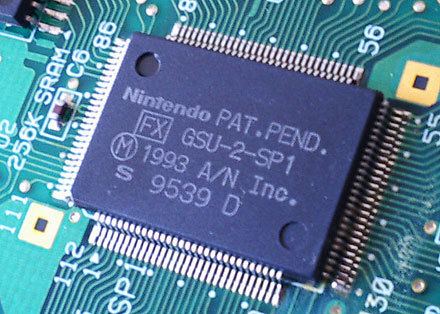 | ||
The Super FX is a coprocessor on the Graphics Support Unit (GSU) added to select Super Nintendo (SNES) video game cartridges, primarily to provide advanced 2D and 3D techniques. The Super FX chip was designed by Argonaut Games, who also co-developed (with Nintendo) the 3D space scrolling shooter video game Star Fox to demonstrate the additional polygon rendering capabilities that the chip had introduced to the SNES.
Overview
While in development, the Super FX chip was codenamed "Super Mario FX" and "MARIO", which is an acronym for "Mathematical, Argonaut, Rotation & Input/Output", where "MARIO" is printed on the face of the final production chip. With the release of Star Fox in 1993, the Super FX became the best selling RISC-based processor at that time.
The chip is used to render 3D polygons and to assist the SNES in rendering advanced 2D effects. This custom-made RISC processor is typically programmed to act like a graphics accelerator chip that draws polygons to a frame buffer in the RAM that sits adjacent to it. The data in this frame buffer is periodically transferred to the main video memory inside of the console using DMA in order to show up on the television display.
Star Fox uses the chip for simple polygon rendering, where the polygons number in the hundreds. It uses scaled bitmaps for lasers, asteroids, and other obstacles, but other objects such as ships are rendered with polygons. Super Mario World 2: Yoshi's Island uses the chip for advanced graphics effects like sprite scaling and stretching, for huge sprites that allowed for boss characters to take up the whole screen, and for multiple foreground and background parallax layers to give a greater illusion of depth.
The first version of the chip, commonly referred to as simply "Super FX", is clocked with a 21.4 MHz signal, but an internal clock speed divider halves it to 10.7 MHz. Later on, the design was revised to become the Super FX GSU (Graphics Support Unit); this, unlike the first Super FX chip revision, is able to reach 21 MHz.
All versions of the Super FX chip are functionally compatible in terms of their instruction set. The differences arise in how they are packaged, their pinout, and their internal clock speed. As a result of changing the package when creating the GSU-2, more external pins were available and assigned for addressing. As a result, a larger amount of external ROM or RAM can be accessed.
Game cartridges that contain a Super FX chip have additional contacts at the bottom of the cartridge that connect to the extra slots in the cartridge port that are not otherwise typically used. Therefore, Super FX games can not be plugged into cartridge adapters which predate the release of Super FX games. This includes cheat devices, such as the Game Genie.
Because of higher manufacturing costs and increased development time, few Super FX based games were made compared the rest of the SNES library. Due to these increased costs, Super FX games often retailed at a higher MSRP compared to other SNES games.
